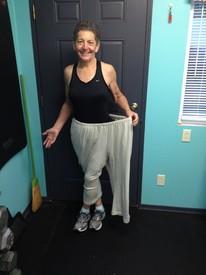Goal for deadlifts and squats

Raegold
Posts: 191 Member
Hey all... I'm new to 'lifting', have recently been working on some functional exercises, and I'm trying to figure out what my goal should be for deadlifts and squats. I'm not looking for hardcore, unmaintainable hypertrophy, I'm really looking for functional strength. I've already been doing Pilates and kettlebell classes, but now I'm adding in heavier weights and different movements.
I'm 34, a stay at home mom, was a nurse... 5'3, 135 lbs. I was thinking like 50 lbs as a goal for both deadlifts and squats...? I have a SI injury from childbirth in 2012, so I don't want to push things too much. I usually do RDL or sumo DL and goblet squats (usually in my home gym, only have dumbells).
Any insight would be much appreciated!!!
I'm 34, a stay at home mom, was a nurse... 5'3, 135 lbs. I was thinking like 50 lbs as a goal for both deadlifts and squats...? I have a SI injury from childbirth in 2012, so I don't want to push things too much. I usually do RDL or sumo DL and goblet squats (usually in my home gym, only have dumbells).
Any insight would be much appreciated!!!
0
Replies
-
4
-
As heavy as you reasonably can? I mean, goals are great but you'll find that once you hit them you'll immediately want to hit new goals. It's just the way it is.
As far as a reasonable first goal, I don't know, 135lbs? 50lbs is very light, I guarantee you can do it already.0 -
50 lbs is a bit light. I understand SI joint dysfunction sucks and you need to be careful though...
I'm 5'4" and 135. My next deadlift goal is 350 and squat 260. But I started with the bar (45 lbs) a couple years ago.4 -
The lower body is much, MUCH stronger than most people realize. I bet you $5 you can already squat and DL 50lb already.1
-
your goal should be to be a little stronger today than you were yesterday. The number on the bar doesn't matter. Make your first goal to get the form and technique down, and then just try and be a little better today than you were yesterday, whether that is an extra set or an extra rep, or an extra 5 lbs.6
-
i just had a sacroiliac quirk thanks to a pelvic rotation for the first part of this year, so i'm still twitchy about anything that could mess with that joint. not sure what an 'injury' could be, but i can well understand your caution.
with that said, i think that whatever weight feels reasonable and attainable to you is a good goal to start with. there are more objective-type standards charts out there, based on factors like age, gender and body-weight. but if you don't fit into the demographic group that they're based on/addressed to, then they're sort of irrelevant.
for reference: i'm your height and weight, but 18 years older than you and certainly think 50lbs is achievable. all other factors being equal i don't think it's anywhere near what you're probably capable of once you gain some experience. but go to 50 and then once you get there take stock and see how you feel about it. the typical process with most progressive strength training programmes is not so much about lifting a specific weight as a finite goal. it's a lot more about the incremental differences between weights or volumes from one workout and the next.
and when in doubt about the s.i. - find a trainer or possibly a physiotherapist to work with you.0 -
50lb is likely to be problematic with deadlift unless you have access to bumper plates. The bar itself is 20kg/45lb and the plates needed to bring it up to 50lb are tiny meaning it'll be hard to get the bar to the right height.
I'm slightly shorter than you at 5'1" but also heavier at 157lb and my very first target for deadlift was 60kg/135lb so i could use the big plates and then not need to use anything to raise the bar to the correct height. Then my target was bodyweight (which was higher than it is now) and now it's 100kg (I'm at 98.5kg but have a mental block).
With squats the lighter weights don't affect form in the same way, but bodyweight still seems to be a good starting target. My new target is to hit intermediate level on strengthlevel.com which varies depending on weight and age.2 -
First goal should be to squat the bar (45lbs)...deadlift 65lbs (bar + 10lb bumper plates). After that...the sky is the limit.0
-
The goal is always "more weight". Given a proper linear progression, and presuming no injuries, you should be able to squat your bodyweight and deadlift 185 lbs in less than a year.1
-
My big goal right now is to squat body weight (half way there - this is a hard lift for me), and and deadlift body weight (10 lbs short!). Intimately, I'll be really excited to squat 250 lbs and deadlift over 300 lbs.
But what are your goals? Do you just want to be a trim, happy person? Or do you want to compete in powerlifting or something of the sort? Why you lift weight will effect how much you want to lift.2 -
5 lbs more than last week.5
-
I'm really looking for functional strength.
If you're trying to stay strong for everyday tasks, don't feel pressured to lift more than around half your bodyweight, since that's rarely experienced in daily life. Most injuries outside the gym involve relatively light loads, but in unexpected or untrained movements. Developing overkill strength can't compensate for skill deficits. With that in mind, i would keep doing goblets & RDLs, and add dumbbell squats, where you hold 2 dumbbells down between your thighs. Very practical lift. Lunges & farmer's carries are also good to add, to train stability while moving. 3
3 -
Cherimoose wrote: »
If you're trying to stay strong for everyday tasks, don't feel pressured to lift more than around half your bodyweight, since that's rarely experienced in daily life. Most injuries outside the gym involve relatively light loads, but in unexpected or untrained movements. Developing overkill strength can't compensate for skill deficits. With that in mind, i would keep doing goblets & RDLs, and add dumbbell squats, where you hold 2 dumbbells down between your thighs. Very practical lift. Lunges & farmer's carries are also good to add, to train stability while moving.
Ignore all of the above quoted text.
Being stronger prevents injuries by strengthening not only muscles, but all those ligaments, tendons, and bones that hold you together. Someone who can deadlift one hundred pounds is going to have to exert more of their total power on ANY lift off the floor than the person who can deadlift two hundred pounds.
3 -
Cherimoose wrote: »I'm really looking for functional strength.
If you're trying to stay strong for everyday tasks, don't feel pressured to lift more than around half your bodyweight, since that's rarely experienced in daily life. Most injuries outside the gym involve relatively light loads, but in unexpected or untrained movements. Developing overkill strength can't compensate for skill deficits. With that in mind, i would keep doing goblets & RDLs, and add dumbbell squats, where you hold 2 dumbbells down between your thighs. Very practical lift. Lunges & farmer's carries are also good to add, to train stability while moving.
Thank you for the advice! I am trying to stay strong for my everyday life- kids, groceries, etc. I'm not looking to do any sort of competitions at all. I think that lifting my body weight wouldn't really be helpful, and I'd probably end up injuring myself since my left SI is unstable.
When you say dumbbell squats with the dumbells between your thighs, do you mean in a sumo type stance?
I've been doing curtsy and reverse lunges with 10-15lbs, and walking lunges carrying asymmetrical loads. Have not done farmers carries, but I'll look that up tonight. Thanks!!
1 -
deputy_randolph wrote: »First goal should be to squat the bar (45lbs)...deadlift 65lbs (bar + 10lb bumper plates). After that...the sky is the limit.
Thanks, that definitely makes sense!
0 -
Since you mentioned hypertrophy, I think someone should point out that's very unlikely for a woman to develop by accident. You can lift heavy and not worry about turning into She Hulk. Very few women naturally have the hormones to develop huge muscles.2
-
When you say dumbbell squats with the dumbells between your thighs, do you mean in a sumo type stance?
I've been doing curtsy and reverse lunges with 10-15lbs, and walking lunges carrying asymmetrical loads. Have not done farmers carries, but I'll look that up tonight. Thanks!!
Asymmetrical-load walking lunges & farmers carries are excellent complements to squats & deadlifts. Loaded stair climbs are great too. I'd skip the curtsy lunges. The hips & knees really aren't designed to bend that way with a heavy load, so it can be hard on them. For lateral training, side lunges are much better..
Yes, the DB squat is sort of like a sumo. Typically the feet are just wide enough to accommodate your arms, which are parallel to each other, sort of like this: 0
0 -
Cherimoose wrote: »I'm really looking for functional strength.
If you're trying to stay strong for everyday tasks, don't feel pressured to lift more than around half your bodyweight, since that's rarely experienced in daily life. Most injuries outside the gym involve relatively light loads, but in unexpected or untrained movements. Developing overkill strength can't compensate for skill deficits. With that in mind, i would keep doing goblets & RDLs, and add dumbbell squats, where you hold 2 dumbbells down between your thighs. Very practical lift. Lunges & farmer's carries are also good to add, to train stability while moving.
So you are saying someone who can lift 1.25x or even 1.5x body weight has "overkill" strength and would be just as likely being injured lifting a 20lbs object than someone who could not even lift their own body weight?
If that's the case then I strongly disagree with that statement. A person with your "overkill" strength might make the same mistakes lifting an object as a weak person. It's just they are more likely to not injure themselves doing it because said weight is a much lower percentage of what they can lift.2 -
Cherimoose wrote: »I'm really looking for functional strength.
If you're trying to stay strong for everyday tasks, don't feel pressured to lift more than around half your bodyweight, since that's rarely experienced in daily life. Most injuries outside the gym involve relatively light loads, but in unexpected or untrained movements. Developing overkill strength can't compensate for skill deficits. With that in mind, i would keep doing goblets & RDLs, and add dumbbell squats, where you hold 2 dumbbells down between your thighs. Very practical lift. Lunges & farmer's carries are also good to add, to train stability while moving.
So you are saying someone who can lift 1.25x or even 1.5x body weight has "overkill" strength and would be just as likely being injured lifting a 20lbs object than someone who could not even lift their own body weight?
If that's the case then I strongly disagree with that statement. A person with your "overkill" strength might make the same mistakes lifting an object as a weak person. It's just they are more likely to not injure themselves doing it because said weight is a much lower percentage of what they can lift.
Bingo.
Strength is never a weakness.3 -
So you are saying someone who can lift 1.25x or even 1.5x body weight has "overkill" strength and would be just as likely being injured lifting a 20lbs object than someone who could not even lift their own body weight?
Nope, i'm saying that people who squat more than 1/2 their bodyweight can and do get injured due to skill deficits, so before progressing past 1/2 bodyweight squats, diversify the training to ensure that skills improve at the same rate as strength. There are people who can squat 1x bodyweight but can't do a walking lunge with a 1/4 bodyweight dumbbell in one hand without toppling sideways. That's a red flag.
Once the weight increases past a certain point, the functional benefits start leveling off, and there's an increased risk of training injuries & burnout. So like with running, having huge lifting goals isn't realistic for everyone.. especially those with orthopedic issues like the OP. Fortunately it doesn't require a lot of weight to have good functional capacity.
4 -
Cherimoose wrote: »Nope, i'm saying that people who squat more than 1/2 their bodyweight can and do get injured due to skill deficits, so before progressing past 1/2 bodyweight squats, diversify the training to ensure that skills improve at the same rate as strength. There are people who can squat 1x bodyweight but can't do a walking lunge with a 1/4 bodyweight dumbbell in one hand without toppling sideways. That's a red flag.
Once the weight increases past a certain point, the functional benefits start leveling off, and there's an increased risk of training injuries & burnout. So like with running, having huge lifting goals isn't realistic for everyone.. especially those with orthopedic issues like the OP. Fortunately it doesn't require a lot of weight to have good functional capacity.
It's hard to know where to begin with this nonsense.
Skills aren't trained by strength training. Specific skills are trained by practicing those skills. Increasing strength in frail individuals balance, as demonstrated in multiple studies. Good form always trumps the weight on the bar; with good lifting form strength training is one of the safest exercise modalities in existence.
Very frequently, untrained males can successfully - and with good form - squat half their body weight in their first session under the bar. Hell, I was able to three weeks after I was cleared to resume lifting after open heart surgery.
There's definitely a point of diminishing returns; before the end of a linear progression program - where a trainee can put weight on the bar every session - isn't it, and plenty of trainees can get to 150% body weight squats in their first six months. Reaching diminishing returns doesn't happen until late in a strength trainee's intermediate programming.
Finally, orthopedic issues can be fully countered with a strength program. Brian Jones has a video on Youtube talking about his journey from two shattered legs to a solid finisher in powerlifting contests.5 -
So you are saying someone who can lift 1.25x or even 1.5x body weight has "overkill" strength
i don't really get why that's such a stunning idea. ain't nowhere in my own life i come across the kind of weight that i go to the gym to deal with - that's why i have to go to a gym to get it. what's wrong with pointing out that most people who do weight train probably are a lot stronger than they ever actively need to be?
further, the op has a pre-existing injury which affects a pretty major series of joints. and if she doesn't need - or want - more than a certain level of genuinely functional strength, what's the point of getting all huffy and puffy about someone who is sensible enough to bring up the real-life-risk-versus-real-life-reward thing. not everyone wants or needs to be a workout hero, and some people shouldn't even be trying, probably.
seems like a pretty silly thing to start an argument on, but then again i'm in here adding my two cents to it.4 -
First off to disagree with someone's opinion is not an argument. It can lead to one but only if people let their emotions get the better of them.
Back to the idea of "overkill" strength. You know what else could be considered "overkill", anyone in modern western society running for more than maybe 3km. The chance of serious injury is pretty high in comparison to many other activities. Outside of sport/fitness I bet most have had no reason to even walk more than a few km a day.
That sounds just as foolish to me that lifting body weight or possibly slightly more is "overkill". It diminishes the work people put in to reach these simple goals and encourages people to limit themselves.
Besides let's look at a 140lbs female at 5'6". Solidly in average BMI range for 40 years old. Lifting 70lbs is all that would be needed according to the post I quoted. Concidering that an average 4 year old is around 40lbs you are already picking up 50% of a 1rm by these standards. While not too heavy picking up an uneven weight and holding for a few minutes at 50% would get tiring, not to mention dangerous.
Same person who could lift body weight is only picking up less than 30% of 1rm. Which one do you think has an easier time? I am not even getting into that grisly "overkill" range of being able to lift more than your body weight.
No where do we state learning form is bad. I also don't think doing functional fitness is bad. I do disagree that being able to squat or deadlift your body weight is "overkill". If someone has a limitation of course they should do less. It's the blanket statements I don't like.0 -
I definitely didn't mean to start an argument here! Although the discussion is interesting... I had a pretty serious injury during childbirth- separated pubic syphysis and separated left SI joint. Things are much much better now, but both joints are still unstable and easily injured if I don't have great form or do high impact movements. So I was inquiring from that standpoint, not from the everyday person with a relatively stable pelvis1
-
Also, I appreciate the feedback... I think I need to continue diversifying some of my movements, and improving on the ones that are more difficult. Step ups are one that is tough for my left glute to fluidly activate on even with very low weight. And I want to improve on my lunges and split squats. And obviously core strength is always up there.1
-
That's absolutely untrue. You weigh more than half your body weight, and that's a weight you encounter all day and every day.Cherimoose wrote: »I'm really looking for functional strength.
If you're trying to stay strong for everyday tasks, don't feel pressured to lift more than around half your bodyweight, since that's rarely experienced in daily life. Most injuries outside the gym involve relatively light loads, but in unexpected or untrained movements. Developing overkill strength can't compensate for skill deficits. With that in mind, i would keep doing goblets & RDLs, and add dumbbell squats, where you hold 2 dumbbells down between your thighs. Very practical lift. Lunges & farmer's carries are also good to add, to train stability while moving. Cherimoose wrote: »I'm really looking for functional strength.
Cherimoose wrote: »I'm really looking for functional strength.
If you're trying to stay strong for everyday tasks, don't feel pressured to lift more than around half your bodyweight, since that's rarely experienced in daily life. Most injuries outside the gym involve relatively light loads, but in unexpected or untrained movements. Developing overkill strength can't compensate for skill deficits. With that in mind, i would keep doing goblets & RDLs, and add dumbbell squats, where you hold 2 dumbbells down between your thighs. Very practical lift. Lunges & farmer's carries are also good to add, to train stability while moving.
Thank you for the advice! I am trying to stay strong for my everyday life- kids, groceries, etc. I'm not looking to do any sort of competitions at all. I think that lifting my body weight wouldn't really be helpful, and I'd probably end up injuring myself since my left SI is unstable.
When you say dumbbell squats with the dumbells between your thighs, do you mean in a sumo type stance?
I've been doing curtsy and reverse lunges with 10-15lbs, and walking lunges carrying asymmetrical loads. Have not done farmers carries, but I'll look that up tonight. Thanks!!
OK, so If you want to get strong with daily life, figure out what you lift in daily life, or might lift in daily life.
Body weight+ is a good goal.
10-15 lbs is interesting when you're working on form, but you'll want to progress. A bag of groceries can be 25-30 lbs. a kid can be 60 or more.
SO called functional movements are great if you're working with a functional load, but if you're doing them with anemic weights, you're not going to get stronger, and you're not going to get better at doing the movements.
If you're going to do a dumbbell squat, I would recommend against the sumo, since that's much more of a hinge(deadlift) movement. Not that there's anything wrong with doing dumbbell deadlifts, but do deadlifts, not squats from the sumo position.
for squats, Bring the dumbells or kettlebells up to the "racked" position with your elbows locked into your ribs and your shoulders naturally in the packed or down position.
2 -
Consider, that with each step you take on a set of stairs is a "mini one legged squat" of your current body weight... your legs are considerably stronger than you imagine. As for goals... use your body weight as a gauge... 1/4; 1/2; 3/4... lifting will only improve your joint health (along with a balanced diet). Consider the yin and yang of lifting... muscle endurance... or maximizing strength... you could shoot for a one rep max... or do mega reps with a significantly lower weight... it's the difference between a pro cyclist who can ask his muscles to push a bike for 120 miles in an afternoon... or Usain Bolt... who uses his power to push himself 100 m in less than 10 seconds... if you are strictly after a level of fitness... consider not using weights... and engage in body weight exercises... push ups, pull ups... box jumps... planks, sit ups, jump squats... weights are for folks who want to exceed "average"...0
-
CipherZero wrote: »It's hard to know where to begin with this nonsense.
Easy there, CZ, or you might need more heart surgeries.
It seems we're miscommunicating, because you're talking about the diminishing returns of adding weight to the bar, i'm talking about the diminishing returns of strength training on handling tasks outside the gym. Most of those functional benefits happen from the first 100 lbs - from lifting SOME weights rather than no weight. For example, increasing one's squat from zero to 100 lbs might give someone an 80% less risk of injury while picking up their kid.. but bumping up their squat from 100 to 200 might only give an extra 5% reduction in risk. So the benefits don't keep increasing in proportion to the weight. Most of them happen early on.
I admire your optimism that strength training can cure orthopedic issues and that everyone can lift with perfect form all the time, but my experience with watching others in gyms is that it's like driving - people are going to screw up sometimes. And errors are less forgiving at higher loads, which require much tighter tolerances in form to prevent serious injury. Fortunately, like i said, having functional capacity doesn't require an endless progression in training load.. just like how running ultramarathons isn't the required dose for cardiovascular health.
3 -
I also don't think doing functional fitness is bad. I do disagree that being able to squat or deadlift your body weight is "overkill". If someone has a limitation of course they should do less. It's the blanket statements I don't like.
No blanket statements here. My advice was specifically to someone with a serious orthopedic issue who was being told "the goal is always more weight" (which i doubt her orthopedist recommends). And my advice to her was about her exercises, not back squats. Goblet squats are significantly harder than back squats, so less weight is a requirement. And RDLs can be harder for women than barbell DLs, because the arms don't get a rest between reps.
Now that i think about, she's probably better off checking with her doctor or PT before following any of our advice.
1 -
Cherimoose wrote: »Now that i think about, she's probably better off checking with her doctor or PT before following any of our advice.

I completely agree with this.
0
This discussion has been closed.
Categories
- All Categories
- 1.4M Health, Wellness and Goals
- 398.3K Introduce Yourself
- 44.7K Getting Started
- 261K Health and Weight Loss
- 176.4K Food and Nutrition
- 47.7K Recipes
- 233K Fitness and Exercise
- 462 Sleep, Mindfulness and Overall Wellness
- 6.5K Goal: Maintaining Weight
- 8.7K Goal: Gaining Weight and Body Building
- 153.5K Motivation and Support
- 8.4K Challenges
- 1.4K Debate Club
- 96.5K Chit-Chat
- 2.6K Fun and Games
- 4.7K MyFitnessPal Information
- 17 News and Announcements
- 21 MyFitnessPal Academy
- 1.5K Feature Suggestions and Ideas
- 3.2K MyFitnessPal Tech Support Questions














